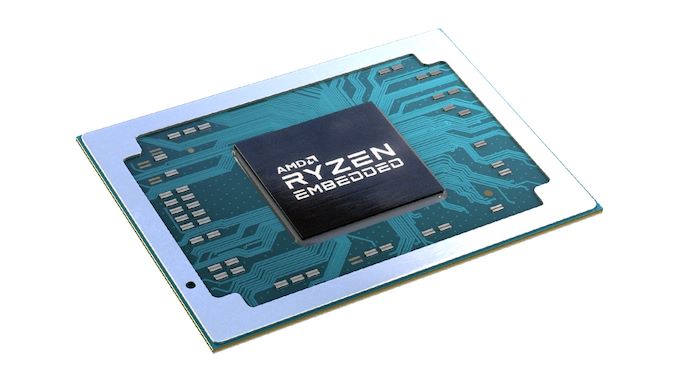AMD Releases Ryzen Embedded 5000 Series For Embedded Networking Products
AMD has announced their latest processor line-up designed for embedded-class products, the Ryzen Embedded 5000 series. The latest parts adds to their collection of other Zen 3-based embedded platforms, including the Ryzen Embedded V3000 and EPYC 9004 series. At a high level, the Ryzen Embedded 5000 series is designed to offer a low-powered alternative on its existing AM4 platform for embedded networking solutions such as firewalls and NAS-based systems.
While we've previously discussed the proposition that AMD's Ryzen Embedded platforms fly under the radar compared to their other product lines, AMD's Ryzen Embedded platforms offer various SKUs for many 'always on' system deployments. This includes things such as servers, small form factor systems such as retail tills, as well as gaming machines, and industrial control systems.
AMD has announced four Ryzen Embedded 5000 series processors designed for their AM4 desktop platform, each SKU offering something slightly different. As AMD's embedded solutions are typically designed to be scalable, the top SKU, the Ryzen Embedded 5950E, features 16 Zen 3 cores, with a base frequency of 3.05 GHz and a 1T boost frequency of up to 3.4 GHz. AMD also has a 12-core variant, the Ryzen Embedded 5900E, which along with the 5950E, also benefits from 64 MB of L3 cache (32 MB per CCX) and a base TDP of just 105 W.
| AMD Ryzen Embedded 5000 Series (Vermeer) | ||||||||
| AnandTech | Core/ Thread |
Base Freq (MHz) |
1T Boost Freq (MHz) |
PCIe 4.0 Lanes | Memory Support |
L3 Cache |
TDP (W) |
|
| Ryzen Embedded 5950E | 16 | 32 | 3050 | 3400 | 24 | DDR4-3200 (ECC) | 64 MB | 105 |
| Ryzen Embedded 5900E | 12 | 24 | 3350 | 3700 | 24 | DDR4-3200 (ECC) | 64 MB | 105 |
| Ryzen Embedded 5800E | 8 | 16 | 3400 | 3700 | 24 | DDR4-3200 (ECC) |
32 MB | 65-100 |
| Ryzen Embedded 5600E | 6 | 12 | 3300 | 3600 | 24 | DDR4-3200 (ECC) |
32 MB | 65 |
The AMD Ryzen Embedded 5800E is the only SKU in the line-up with a configurable TDP, which can be configured between 65W and 100 W. The 5800E also benefits from 32 MB of L3 cache, with a base frequency of 3.4 GHz and a 1T boost frequency of up to 3.7 GHz. The fourth and final SKU, the Ryzen Embedded 5600E, is a 6C/12T part with a base frequency of 3.3 GHz, a 1T boost frequency of up to 3.6 GHz, and also has 32 MB of L3 cache with a TDP of just 65 W.
All of AMD's Ryzen Embedded 5000 series processors natively feature 24 PCIe 4.0 lanes, while AMD's X570 chipset is also available for OEMs who need the additional 12 PCIe 4.0 lanes offered through its PCIe switch. The platform also supports DDR4-3200 ECC memory in dual channel configurations, as well as support extending to other AM4 platforms, although AMD doesn't specifically state which AM4 chipsets will accommodate these chips.
AMD's Corporate VP and GM, Rajneesh Gaur, says that "Ryzen Embedded 5000 processors deliver the ideal combination of performance and reliability required for 24x7 security and networking applications", as well as following up with the following "This expansion of our embedded product portfolio offers a mid-range solution that fills the gap between our low-power BGA Ryzen Embedded and our world-class EPYC embedded family for customers requiring both high performance and scalability of up to 16 cores."
Also, in the official press release, AMD states, "The Ryzen Embedded 5000 Series rounds out the "Zen 3"-based AMD embedded processor portfolio." This means these Ryzen Embedded 5000 series SKUs are likely the last of its Zen 3 microarchitecture within its embedded platforms. Still, AMD's already announced its Zen 4 EPYC 9004 embedded platform based on its Zen 4 microarchitecture, and it's fair to assume that newer iterations of future embedded platforms will also be based on Zen 4 in the future.
The AMD Ryzen Embedded 5000 series is currently in production and offers at least five years of manufacturing availability. AMD, at this time, hasn't shared when these chips will be available to buy nor how much they may cost.
from AnandTech https://ift.tt/vBOF0Qh


Post a Comment